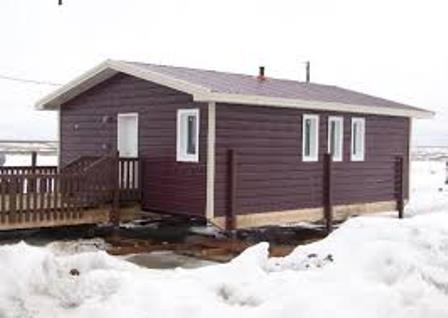 |
Home | En Español | Contact Us | A to Z |
 |
SM-ARCTICBARROW - Some of the most innovative housing that you're likely to find these days is being built in some of the smallest, most out-of-the-way places, in native Alaskan villages like Point Lay, population 247, or Anaktuvuk Pass, population 282, north of the Arctic Circle and some 3,300 miles from Washington, D.C. The innovation was sparked by the Northern Sustainable Shelter Initiative, launched by HUD and other federal partners including the U.S. Department of Agriculture, the Denali Commission and EPA as well as the State of Alaska, native regional housing authorities and the Cold Climate Housing Research Center (CCHRC). The Initiative is confronting one simple fact of life--housing designed to work in the Lower 48 can't withstand the climatological rigors of our 49th state, Alaska.
Which is why, with funding from HUD's NAHASDA Indian Housing Block Grant and technical assistance from CCHRC, native villages across Alaska are busy building affordable, energy-efficient prototype houses designed to "fit"--and to last--in Alaska. The houses aren't big or glitzy. How they look isn't the priority. How they work is. HUD's Northwest Regional Administrator Bill Block recently visited the CCHRC on the campus of the University of Alaska at Fairbanks to find out more. He was, no surprise, impressed. "You can't build a house on permafrost, because the warmth of the house will gradually melt the permafrost," he reported. "Traditionally this was solved by building on stilts, but that created an extra area for cold to enter--along the whole underside of the house." CCHRC, he added, "developed a system of super-insulated foundation that allows houses to be built directly on, and without disturbing, the permafrost." Permafrost is just the first of many challenges. "We would not think it here, but the very joists that connect interior and exterior walls conduct cold. Even though you insulate between the joists, the joists themselves reduce the R rating." CCHRC "developed a system of exterior insulation that creates extremely effective heat retention." Reducing the heat you lose leaves you with more heat to manage. "With very efficient insulation," Bill noted, "it is essential to have air exchange so that moisture does not build up." Some homeowners, the Center found "would turn off the air exchange just to save a few pennies" and that meant a build-up of "very dangerous moisture and mold." CCHRC "developed a heating system integrated with an air exchange" so that homeowners "cannot turn off one without turning off the other." The Initiative's goal is simple. How it gets there is much more complex, employing both state-of-art and traditional native building techniques. Soy-foam insulation with an R-60 rating. Solar thermal panels to provide residents with hot water. Self-contained sewage treatment. Wind turbines to generate electricity. Packing earth--Nature's first insulator--up against two or three of a house's exterior walls. The results are promising. In September 2014, the Tagiugmiullu Nunamiullu Housing Authority on the North Slope completed construction of seven homes in Anaktuvuk Pass and Point Lay. Designed with help from CCHRC, TNHA hoped--but wasn't sure--they'd be the kind of sustainable, energy-efficient building homes built to work and last in the Arctic. "Wow!," TNHA declared once results came in. All seven earned a 6-star BEES--or Building Energy Efficiency Standards--rating. Not many houses anywhere in Alaska ever have. Certainly not on the North Slope. The typical house there uses more than 859 gallons of heating oil each year. In March 2014, the U.S. Energy Information Administration said the average U.S. price of a gallon of heating oil was $4.12 which means $3,359 a year for a North Slope family. That's a good-sized hole in any family's pocket. Results suggest TNHA's new houses will use just 140 gallons a year or, as TNHA is happy to report, "just 16.2 percent of the heating oil used by the average North Slope home!" TNHA chief executive officer Daryl Kooley is "confident" the same will be true for the 10 additional houses coming on-line in Kaktovik and Nuiqsut. Instead of spending $3,359 per season, residents of these houses will spend just $1,404. That's a whole lot smaller hit on a pocketbook. TNHA is not done innovating. "These homes should not be seen as 'the answer'," TNHA says, "but simply as one very promising approach to the challenges faced in our North Slope communities and, perhaps, elsewhere." Developing affordable, energy-efficient that work and last in the communities TNHA serves "remains very much a work in process, constantly changing and evolving as a consequence of lessons learned along the way." HUD is proud to join them on their journey. ### |
||
| Content Archived: January 13, 2016 | ||


